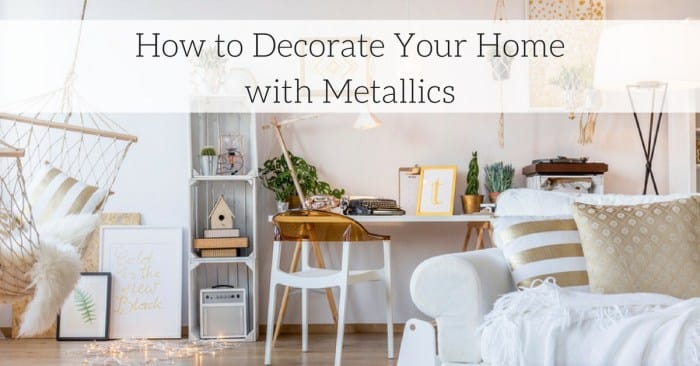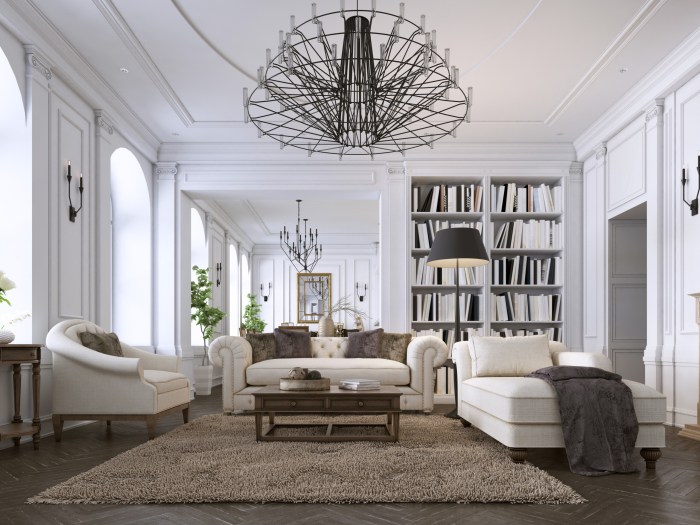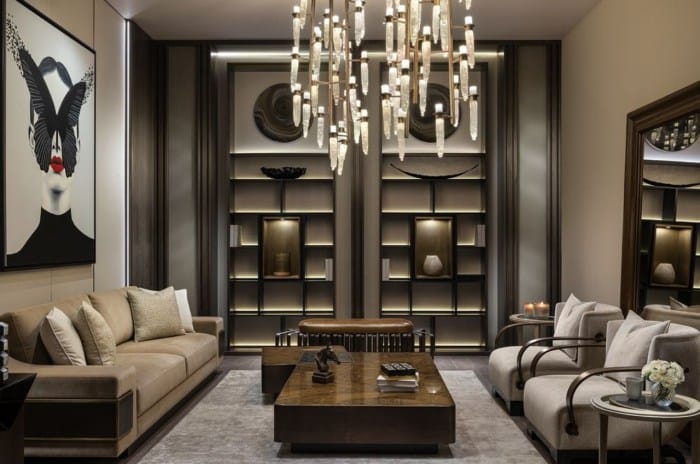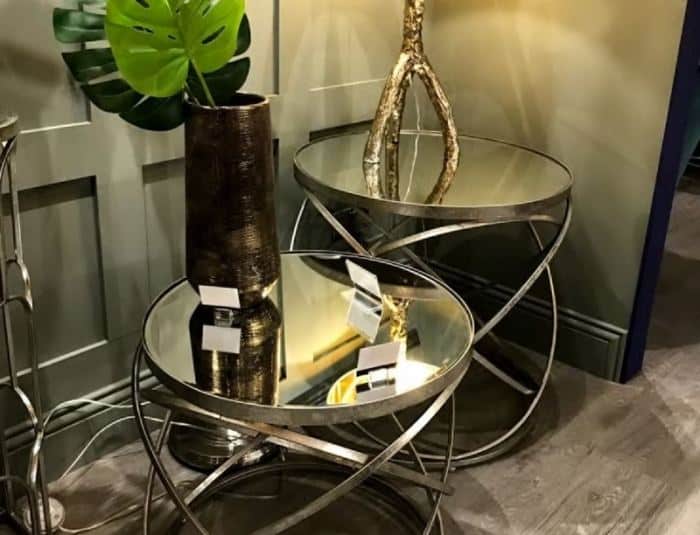Metallic element luxury home decor transcends mere ornamentation; it’s a sophisticated interplay of material science, design aesthetics, and environmental consciousness. From the warm glow of gold leaf to the cool gleam of polished silver, metallic finishes possess a unique ability to transform a space, reflecting light and creating dramatic focal points. This exploration delves into the multifaceted world of metallics in high-end interior design, examining their application, impact, and sustainability.
We’ll explore the diverse range of metals – gold, silver, copper, brass, bronze – each with its distinct properties and visual character. Their varied finishes, from brushed to polished, hammered to mirrored, offer a spectrum of textures and reflective qualities. We will analyze how these elements integrate seamlessly into different interior design styles, from classic to contemporary, and how their use can dramatically alter the mood and ambiance of a room.
The journey also includes a discussion on sustainable sourcing and the environmental impact of these materials, ensuring a responsible approach to luxurious design.
Defining “Metallic Element Luxury Home Decor”

Metallic element luxury home decor transcends mere ornamentation; it’s a design philosophy that leverages the inherent beauty and unique properties of metals to create opulent and sophisticated interiors. This approach utilizes the visual impact, tactile qualities, and even the historical associations of various metals to elevate the aesthetic and perceived value of a space. The key is a careful selection and integration of these elements to achieve a harmonious and luxurious overall effect, avoiding gaudiness or an overly ostentatious display.Metallic element luxury home decor is characterized by the strategic incorporation of metals into various design features, creating a sense of richness and refinement.
This isn’t simply about adding metallic accents; it’s about thoughtfully considering the interplay of light, texture, and the overall design scheme to create a cohesive and luxurious environment. The chosen metals contribute to the overall mood and ambiance, reflecting the homeowner’s personal style and taste.
Examples of Metallic Elements in Luxury Home Decor
The versatility of metallic elements allows for a broad range of applications in luxury home design. Gold, silver, copper, brass, and bronze are frequently used, each offering a distinct aesthetic and contributing unique properties to the overall design. Gold, for instance, exudes opulence and warmth, often associated with royalty and prestige. Silver, on the other hand, provides a cooler, more modern feel, often paired with sleek lines and minimalist designs.
Copper’s warm reddish-brown hue brings a sense of rustic elegance, while brass offers a slightly more vibrant golden tone, and bronze provides a darker, more antique aesthetic. The choice of metal directly influences the mood and style of the space.
Finishes and Textures in High-End Metallic Decor
The finish and texture of the metallic elements are crucial in determining the overall aesthetic. High-end metallic decor often employs sophisticated finishing techniques to enhance the visual appeal and durability of the materials. For instance, gold can be finished with a high polish for a dazzling shine, or a brushed finish for a more subdued, matte appearance. Silver can similarly exhibit high-polish or brushed finishes, as well as hammered or textured effects for added visual interest.
Copper often features a patinated finish, showcasing its natural aging process and adding a layer of depth and character. Brass can be polished to a high shine or left with a more natural, slightly tarnished look. Bronze, due to its inherent qualities, often features darker, more rustic finishes, sometimes with intentional distressing for an antique effect. These varied finishes and textures allow designers to create a wide range of visual effects, from sleek and modern to rustic and antique, all while maintaining a luxurious feel.
The interplay between different finishes and textures across multiple metallic elements further enhances the complexity and visual richness of the design.
Applications in Interior Design

Metallic elements, encompassing a spectrum from the cool gleam of stainless steel to the warm glow of brass, offer a unique opportunity to elevate interior design. Their inherent reflective properties manipulate light, adding depth and visual interest to any space. The malleability of many metals allows for diverse forms and finishes, catering to a wide range of aesthetic preferences.
Furthermore, the inherent durability of many metals contributes to the longevity and sophistication of the design.The strategic incorporation of metallics significantly impacts the overall ambiance of a room. The choice of metal, its finish (polished, brushed, matte), and its scale influence the perceived temperature and mood. Cool metals like silver and chrome contribute to a modern, sleek aesthetic, while warmer metals such as gold and copper create a sense of richness and opulence.
Metallic Applications Across Room Types
Metallic elements find versatile application across various rooms in the home. In living rooms, metallic accents can be incorporated through lighting fixtures, coffee tables with metallic bases, or decorative sculptures. Bedrooms often benefit from subtle metallic touches in bedside lamps, mirror frames, or subtle metallic thread woven into textiles. Kitchens, frequently characterized by their functional nature, can be stylishly enhanced with metallic backsplashes, faucet fixtures, or handles on cabinetry.
Bathrooms, often spaces emphasizing cleanliness and luxury, often utilize metallic finishes in shower fixtures, towel racks, and vanity hardware. The careful selection and placement of metallic elements in each room contribute to a cohesive and luxurious overall design.
Living Room Design Schemes Incorporating Metallic Elements
Three distinct living room schemes illustrate the versatility of metallic accents. A modern living room might feature a sleek, brushed stainless steel coffee table, paired with a chrome floor lamp and minimalist furniture in neutral tones. The reflective surfaces of the metal create a sense of spaciousness and sophistication, amplified by the clean lines of the furniture. In contrast, a traditional living room scheme could utilize antiqued brass accents on furniture legs, ornate lighting fixtures with gold leaf detailing, and richly textured fabrics in deep jewel tones.
This combination creates a sense of warmth and timeless elegance. Finally, an eclectic living room could incorporate a mix of metals – perhaps a copper pendant light, silver picture frames, and black iron furniture – creating a dynamic and visually interesting space. The juxtaposition of different metals, when carefully considered, can produce a surprisingly harmonious effect.
Metallic Accents in Furniture, Lighting, and Accessories
Metallic accents play a crucial role in defining the overall aesthetic. Furniture can showcase metallic elements in legs, handles, or frames, ranging from subtle brushed nickel on a contemporary sofa to elaborate gold leaf detailing on a traditional armchair. Lighting fixtures, whether floor lamps, pendant lights, or chandeliers, offer significant opportunities to incorporate metallics. A simple chrome floor lamp can create a clean, modern statement, while a multi-branched brass chandelier can be a dramatic focal point.
Accessories, from decorative bowls and vases to picture frames and clocks, provide opportunities for smaller, impactful metallic accents. The strategic use of metallics in these areas elevates the overall design, creating a space that is both functional and aesthetically pleasing. The reflective properties of metals, combined with their inherent durability, contribute to a sense of luxury and longevity.
Color Palettes and Material Combinations

The interplay of color and material is paramount in achieving the luxurious aesthetic of metallic element home decor. The inherent reflective properties of metals, their varying hues, and their capacity to interact with light dictate the overall mood and ambiance of a space. Careful consideration of color palettes and material pairings is crucial for maximizing the visual impact and creating a cohesive design.
The selection of colors should complement the chosen metallic finishes, enhancing their inherent beauty and preventing visual clashes. Similarly, the choice of materials significantly influences the overall texture and feel, contributing to the perception of luxury and sophistication. The following sections explore these crucial aspects in detail.
Metallic Finishes and Complementary Color Palettes
The reflective nature of metallic surfaces interacts dynamically with light and surrounding colors. Understanding this interaction is key to selecting complementary palettes that enhance, rather than detract from, the metallic elements. The table below presents suitable color combinations for popular metallic finishes.
| Metallic Finish | Primary Color | Secondary Color | Accent Color |
|---|---|---|---|
| Gold | Deep Teal | Creamy Beige | Emerald Green |
| Silver | Soft Gray | White | Navy Blue |
| Copper | Dusty Rose | Taupe | Terracotta |
| Bronze | Olive Green | Warm Ivory | Burgundy |
Impact of Material Combinations with Metallic Elements
The strategic combination of metallic elements with other materials significantly impacts the overall aesthetic and tactile experience. The interplay of textures and colors creates depth and visual interest, contributing to the luxurious feel. For instance, the cool gleam of silver accents against the smooth, cool surface of marble creates a sense of refined elegance. Conversely, the warm glow of gold paired with the rich grain of dark wood evokes a feeling of opulent warmth.
Materials such as glass, with its transparency and reflective properties, can amplify the brilliance of metallics, while leather, with its tactile richness, adds a layer of luxurious softness. These pairings create a balanced interplay of visual and tactile sensations, enhancing the overall luxurious experience.
Unexpected Material Pairings for Enhanced Luxury
Moving beyond conventional pairings, exploring unexpected combinations can yield strikingly luxurious results. These pairings often leverage contrasting textures and colors to create a visually arresting and memorable effect. The juxtaposition of seemingly disparate materials can generate a unique sense of sophistication and exclusivity.
- Metallic Accents with Concrete: The raw, industrial texture of polished concrete provides a surprising counterpoint to the sleek sophistication of metallics, creating a modern, high-contrast look.
- Gold Leaf with Velvet: The opulent shimmer of gold leaf against the deep, plush texture of velvet fabric is a classic combination that exudes timeless luxury.
- Silver with Smoked Glass: The cool, reflective qualities of silver are enhanced by the subtle smoky hue of glass, creating a sophisticated and mysterious atmosphere.
- Copper with Reclaimed Wood: The warm tones of copper complement the rustic character of reclaimed wood, resulting in a unique blend of industrial and rustic elegance.
- Bronze with Linen: The earthy tones of bronze pair beautifully with the natural texture and subtle sheen of linen, creating a relaxed yet sophisticated ambiance.
Visual Representation and Style Guides
The interplay of light and metallic surfaces profoundly impacts the aesthetic of a space. Understanding how different metallic finishes reflect and absorb light is crucial for achieving the desired ambiance in metallic element luxury home decor. This section explores the visual impact of various metallic finishes under diverse lighting conditions and provides a framework for creating cohesive and luxurious designs using mood boards and style guides.
The visual properties of metals are significantly influenced by their surface treatment, crystalline structure, and the surrounding light source. For instance, highly polished surfaces like mirror-finished stainless steel exhibit specular reflection, creating bright highlights and sharp contrasts. In contrast, brushed or matte finishes, such as brushed nickel or antique brass, diffuse light more evenly, resulting in a softer, less intense visual effect.
The color temperature of the light source also plays a vital role. Warm, incandescent lighting can enhance the golden hues of brass and copper, while cooler, LED lighting can accentuate the silvery tones of stainless steel or platinum.
Metallic Finish Visual Impact Under Varying Lighting Conditions
Consider the following examples to illustrate the transformative effects of lighting on metallic finishes: A polished chrome fixture in a room with natural sunlight will exhibit brilliant, almost blinding highlights, while the same fixture under soft, tungsten lighting will appear less reflective and more subdued. Similarly, a hammered copper backsplash will appear warm and inviting under incandescent light, but might seem somewhat muted under cool fluorescent lighting.
The interplay between light and surface texture determines the overall visual impact, creating diverse moods and aesthetics.
Creating a Mood Board for a Metallic Element Luxury Home Decor Style
A mood board provides a visual representation of a design concept. To create a mood board for a specific metallic element luxury home decor style, for example, one focused on a “Modern Gilded” aesthetic, carefully select images and materials that embody the desired look and feel.
The mood board might include: A photograph of a sleek, modern architectural space with high ceilings and large windows, showcasing a sense of openness and sophistication. A close-up image of a richly textured, antique brass pendant light, emphasizing its intricate details and warm metallic glow. A sample of luxurious velvet fabric in a deep teal or emerald green, providing a textural contrast and complementary color palette.
A swatch of a polished nickel countertop material to represent the sleek and modern elements. A photograph of a piece of abstract art featuring gold leaf accents, further emphasizing the gilded theme. These elements together evoke a sense of refined opulence and modern elegance. The textures and colors are carefully chosen to complement each other and create a cohesive visual narrative.
Style Guide for Using Metallic Elements in Interior Design
Creating a cohesive and luxurious look with metallic elements requires a thoughtful approach. The following principles serve as a guide:
Principle of Balance: Avoid overwhelming a space with too many metallic accents. Strategically incorporate metallic elements as focal points or subtle accents to maintain balance and visual harmony. For example, a statement metallic chandelier might be paired with more subtle metallic accents in the hardware or decorative elements.
Principle of Contrast: Juxtapose metallic finishes with contrasting textures and materials. The interplay between smooth metallic surfaces and rough-hewn wood or soft fabrics adds depth and visual interest. A polished brass faucet paired with a honed marble countertop is a classic example of this principle.
Principle of Harmony: Choose a limited palette of metallic finishes to maintain visual coherence. Sticking to two or three complementary metals (e.g., gold, silver, and copper) prevents a cluttered or disjointed look. Consider the color temperature and reflective properties of each metal to ensure a harmonious blend.
Principle of Scale: The size and scale of metallic elements should be proportionate to the space. Oversized metallic fixtures in a small room can feel overwhelming, while tiny accents might get lost in a large space. Consider the overall proportions of the room when selecting metallic elements.
Sustainability and Ethical Sourcing
The allure of metallic elements in luxury home décor is undeniable, but their environmental footprint demands careful consideration. The extraction, processing, and disposal of these materials present significant challenges, ranging from habitat destruction to greenhouse gas emissions. Choosing sustainable and ethically sourced options is crucial for minimizing the negative impact of our design choices. This section explores the environmental implications of various metallic elements and highlights sustainable alternatives for luxury interiors.The environmental impact of metallic elements varies considerably depending on the metal itself and the methods used in its extraction and processing.
Aluminum, for instance, boasts a relatively low carbon footprint compared to some other metals due to its high recyclability. However, the bauxite mining required for aluminum production can still lead to deforestation and soil erosion if not managed responsibly. Gold, on the other hand, carries a significantly higher environmental burden, with its extraction often associated with water pollution from cyanide leaching and mercury contamination.
The energy intensity of refining processes for many metals also contributes substantially to greenhouse gas emissions.
Environmental Impact of Metallic Elements
The extraction and processing of metallic elements for home décor contribute to several environmental issues. Mining activities often lead to habitat destruction and biodiversity loss. The use of chemicals and energy-intensive processes in refining results in significant air and water pollution. Furthermore, the disposal of metallic waste contributes to landfill accumulation and potential soil contamination. For example, the mining of copper, a popular choice for luxury home accents, can cause significant water contamination if not carefully managed.
Similarly, the production of stainless steel, often used in high-end kitchen appliances, is energy-intensive and contributes to greenhouse gas emissions. A lifecycle assessment, considering all stages from mining to disposal, is crucial for understanding the full environmental impact of each metallic element.
Sustainable and Ethically Sourced Metallic Materials
Several options exist for incorporating metallic elements into luxury home décor in a more sustainable and ethical manner. Recycled metals, such as reclaimed brass or copper, offer a significant reduction in environmental impact compared to newly mined materials. The use of recycled materials conserves resources, reduces energy consumption, and minimizes waste. Furthermore, sourcing metals from companies certified by organizations like the Responsible Minerals Initiative (RMI) ensures that the supply chain adheres to ethical labor practices and environmental standards.
These certifications provide transparency and accountability, allowing consumers to make informed choices. Consider also using metals with lower embodied energy, such as aluminum, prioritizing responsible mining practices and recycling programs.
Comparison of Environmental Impact of Metallic Finishes
Different metallic finishes also exhibit varying environmental impacts. For example, electroplating, a common process for applying metallic coatings, can involve the use of hazardous chemicals. Powder coating, an alternative, offers a more environmentally friendly option with lower emissions and reduced waste. Polishing and other surface treatments also have environmental implications, with some processes consuming more energy and producing more waste than others.
The choice of finish should consider not only its aesthetic appeal but also its environmental footprint. A detailed comparison of the life cycle assessment for different finishes can guide designers towards more sustainable choices. For example, a comparison between electroplated chrome and powder-coated aluminum might reveal that the latter has a smaller carbon footprint and uses fewer hazardous materials.
End of Discussion

In conclusion, metallic element luxury home decor represents a sophisticated blend of artistry and science. The strategic use of these elements, informed by an understanding of their properties, color interactions, and environmental implications, can elevate a living space into a true sanctuary of style and comfort. By carefully considering material combinations, finishes, and sustainable sourcing, designers can create interiors that are both visually stunning and ethically responsible, ensuring that the legacy of luxurious design extends far beyond the immediate aesthetic impact.
FAQs
What are some cost-effective ways to incorporate metallic accents?
Smaller accents like metallic throw pillows, decorative bowls, or picture frames can add a touch of luxury without breaking the bank. Using metallic paint on existing furniture or accessories is another budget-friendly option.
How do I prevent metallic finishes from looking dated?
Classic metallics like silver and gold remain timeless. Avoid overly trendy finishes or excessive use of a single metallic. Mix metals for a more contemporary, layered look.
How do I clean different metallic finishes?
Always refer to the manufacturer’s instructions. Generally, mild soap and water are suitable for most finishes. Avoid abrasive cleaners that can scratch the surface.
Are there any safety considerations when working with metallic elements in home decor?
Ensure proper ventilation when working with metallic paints or sprays. Handle sharp metallic edges carefully. For electrical fixtures, always use qualified electricians.
How can I choose the right metallic finish for my room’s lighting?
High-polished finishes reflect light intensely, ideal for darker rooms. Matte or brushed finishes diffuse light better, suitable for brightly lit spaces.